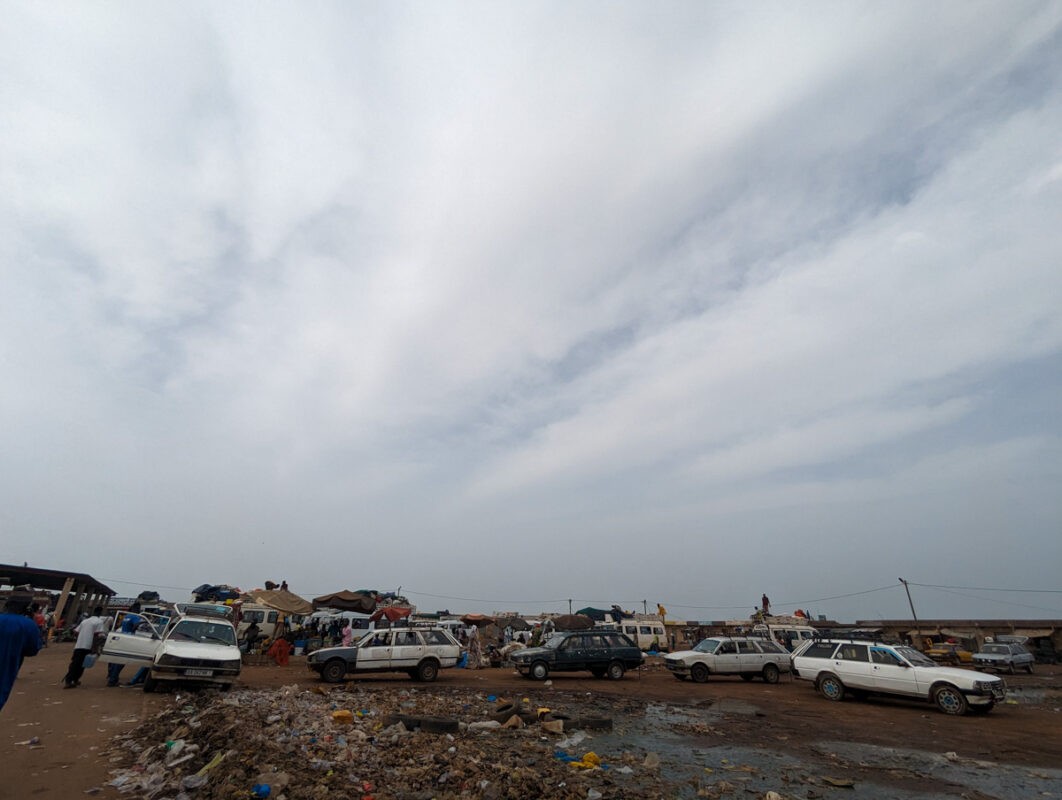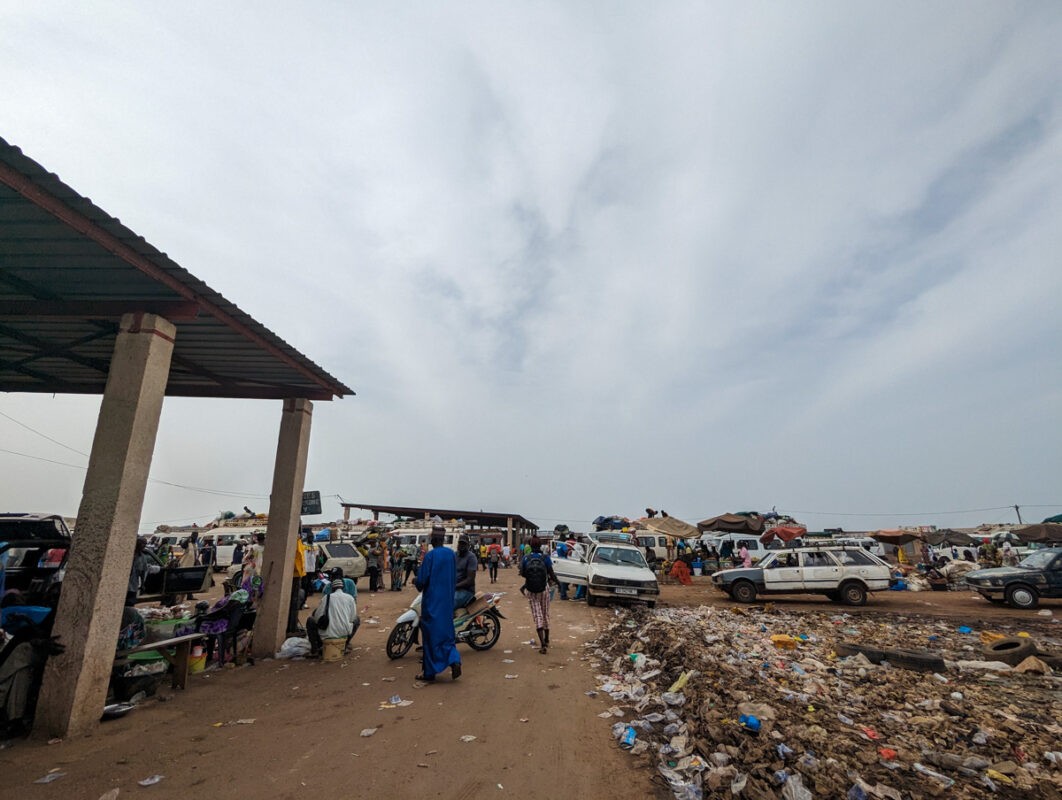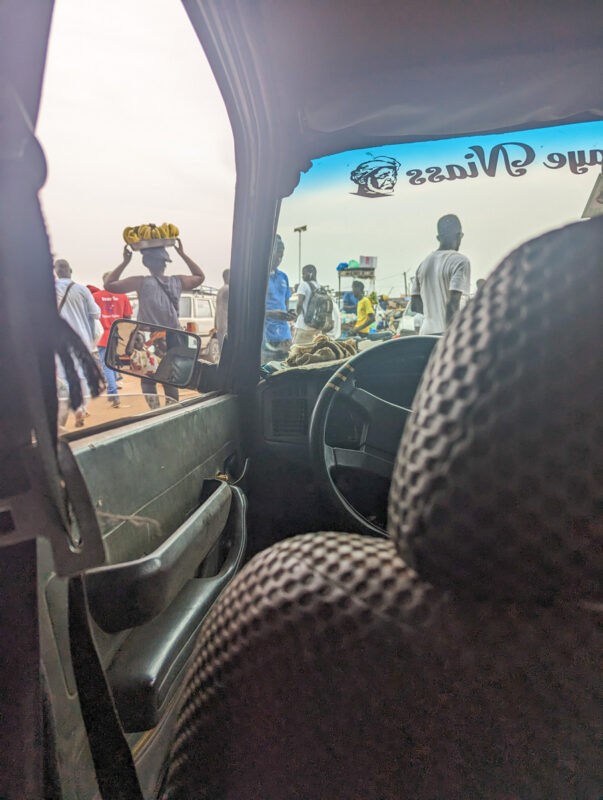If you’re wondering how to get sept-places in Senegal, this blog post is for you!
Senegal is not the easiest place to travel around, but there are options!
Buses connect major cities, but they are few and far between and do need to be booked in advance.
For everything else, there are minibuses and sept-places.
During my three-week trip to Senegal, I didn’t try the minibuses – a few went past us on the road, and they were rammed full of people, with some even hanging off the back, but I did try sept-places a few times.
Minibuses are cheaper than sept-places, but the latter are still pretty affordable and comfortable enough for shorter distances (if a little squashed!).
Here’s all you need to know about taking sept-places in Senegal.
What are sept-places in Senegal?

Sept-places literally means “seven places” in French.
They are converted cars with eight seats; the driver and one passenger in the front, three passengers in the middle and three in the back.
There’s also a boot/ trunk where you can put your luggage. They can be a bit squashed, but it could be worse – over the border in Guinea, the same kind of car is called a neuf-place, seating nine people!
They reminded me a little of the louages in Tunisia.
Where to get sept-places

Most large town or city has a “garage” where the sept-places (and minivans) depart from.
Usually, these are marked on Google maps – but if you’re not sure where to go, ask your hotel staff or taxi driver.
You’ll likely get a taxi to the station (unless you’re walking distance away); if you can speak enough French, double-check with your driver (nous allons au station de sept-place should do it).
Make sure that you agree on a price before getting into the taxi.
Tip: If you’re in Dakar, I recommend the Yango taxi app.
Arriving at the sept-place station

You’ll probably find minivans are on one side, and sept-places are on another.
When we arrived, we were told by minivan drivers that there weren’t any sept-places to Toubakouta (our destination), and we could only get a minivan there.
However, we said we’d go to check on the sept-place section, and we immediately found a sept-place to Toubakouta!
How sept-places work

Payment
Sept-place rates are fixed, so you should pay the same amount as everyone else.
We paid 2,700 XOF ($4.50) each for the hour-long journey from Kaolack to Toubakouta.
The sept-place drivers also charge a negotiable rate for bags – the bigger the bag, the higher the cost! We were quoted 2,000 XOF ($3.30) each for our bags, which we haggled down to 1,000 XOF ($1.15).
When sept-places leave
Sept-places leave when they’re full.
This means that you might be waiting an hour, two hours, three hours… however long it takes for the vehicle to fill up with people!
We were quite lucky – we were the first people there and waited for around half an hour.
Our sept-place actually left with only six passengers, but we picked another up just outside the garage.
The garages
Kaolack garage was a rather chaotic place – and I imagine others are similar!
The site was chock-a-block with cars, each pounding with people.
Sellers walked around offering bananas, peanuts and water.
There were some simple squat toilets in the corner (which cost 100 XOF to use); I presume all stations probably have some!
Driving conditions

Roads outside of the main cities in Senegal are generally not too busy, and we found the driving conditions to be fine.
The cars are very old, and I imagine they break down a lot, but ours made it to Toubakouta without a hitch!
There are seatbelts in the front of the car, but not in the back six seats; so while it didn’t feel dangerous, the driving conditions may be a little different to what you’re used to.
I was in the middle seat between my partner and another passenger, and didn’t find the conditions to be too cramped (but I could lean on my partner a little which made it more comfortable!).
That said, all our hand luggage was on our lap as there was no space in the footwell.
It was comfortable enough for an hour’s ride, but might have got a bit too cramped after 2-3 hours!
Arriving at your destination
Our sept-place travelled all the way to the Gambian border, and we were disembarking by the village of Toubakouta (gateway to the Saloum Delta UNESCO site, one of the top places in Senegal).
Toubakouta doesn’t have a sept-place station, so we disembarked on the side of the road.
This meant that we had to let the driver know when we were nearing where we wanted to get out.
From here, we walked to our accommodation (although we could have grabbed an unofficial taxi).
Depending on where you’re going, you might end up at a sept-place station – or just keep an eye on your maps to see when you’re nearing – you can ask the driver to stop pretty much anytime that it’s safe to do so.
To see the experience, take a look at my YouTube video:
Senegalese public transport
So, that’s all you need to know about sept-places in Senegal!
If you fancy a slightly comfier and more organised journey, Senegalese buses also operate (although ours was delayed for four hours!).
However, sept-places are often the easiest option to travel around Senegal and, once you know how they work, they’re relatively straightforward!
